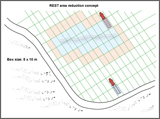Background: Mine searchers currently investigate whether the pace at which the dogs work may be accelerated by using a modification called Remote Explosive Scent Tracing (REST): instead of taking the dogs into the mine field, samples from the soil surface of the mine field are collected. The most common procedure is to vacuum pump dust from the soil surface and to store the collected dust in containers. Typically, dust from a stretch of 100 m length and 2 m width can be combined in one sample. Sampling is done from a mine-proof vehicle or by walking and collecting from mine-free lanes, e.g. cleared by mine proof vehicles).
After collecting, the dust samples are taken to a central unit (i.e., remote to the field) where the samples are subsequently analyzed by the mine detection dogs. Compared to taking the dogs into the field, this method is advantageous in that
- a much larger area can be covered in a given time,
- lower operational costs,
- the dogs work more reliable as the conditions in the central unit are better standardized and more comfortable than in the field with regard to temperatures, air movement, and humidity.
Question: For mine detection dogs it is important that they are trained on an odour signature pattern that is as similar as possible to the one that they encounter on the soil surface above mines in the actual mine clearing operation. Do you think that training on military grade TNT is a reasonable thing to do? (TNT is the stuff that is contained in most mines. Besides 2,4,6-TNT it typically contains a few percent of 2,4-DNT.)
Answer: There are many processes going on in the soil that will alter the signature pattern as compared to a chunk of military grade TNT:
- Diffusion through the mine casing => the molecular size of SNT is smaller than TNT and therefore its diffusion velocity will be larger ( see Chapter 6).
- Outside the mine casing the major transport path to the soil surface is with water that creeps upwards in the capillaries of the soil when the soil surface dries out. Partitioning into this water is different for different chemicals.
- TNT has been shown to be degraded much faster than DNT. This lowers the TNT concentration and generates an additional odour (Amino-DNT) that might serve as a signature compound to the dogs.
- Partitioning between the soil surface and the air also is different from partitioning between "pure" military grade TNT and the air.
In addition, all mentioned processes are affected by many factors such as type of mine casing, soil texture, moisture conditions, vegetation, temperature, wind a.s.o. Thus it becomes clear that the dogs need to be prepared with many different odour patterns that can indicate the presence of a mine. This makes training of mine detection dogs a huge challenge. A realistic training would have to be done on hundreds of real buried mines (without a fuze) being in the ground for more than 6 months, presenting different mine types, buried in different soils at different depths and in different climates. It is obvious that this is not realistic for many practical reasons. Different dog trainers have come up with quite different ideas on how to make the training procedure as realistic as possible.
Download this page as a pdf
 |
Proceed |
| |
|
 |
|
|

mine proof vehicles: picture

remote explosive scent tracing: movie

REST area reduction concept: picture

mine detection dogs: movie
|





 Answer 3
Answer 3



